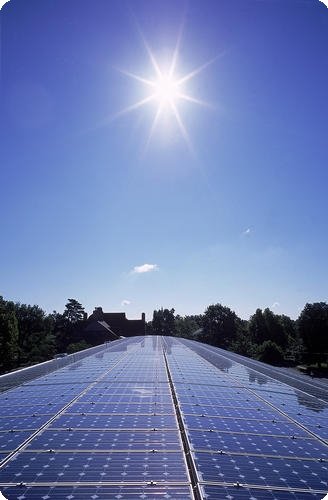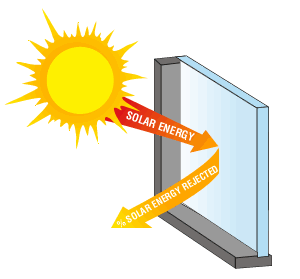Solar Panels
Solar Panels
 Solar panels (arrays of photvoltaic cells) make use of renewable energy from the sun, and are a clean and environmentally sound means of collecting solar energy. Here at solar panel information, we've amassed a wealth of information relating to solar panels and the field of photovoltaic technology. You can learn how solar panels work, how they are manufactured, where to buy them, and how to set them up. If you are looking for information on solar panels and don't know where to start, check out our solar panels section to learn more about how these photovoltaic cells are derived from silicon and what solar energy means to you.
Solar panels (arrays of photvoltaic cells) make use of renewable energy from the sun, and are a clean and environmentally sound means of collecting solar energy. Here at solar panel information, we've amassed a wealth of information relating to solar panels and the field of photovoltaic technology. You can learn how solar panels work, how they are manufactured, where to buy them, and how to set them up. If you are looking for information on solar panels and don't know where to start, check out our solar panels section to learn more about how these photovoltaic cells are derived from silicon and what solar energy means to you.
How Panels are made
Crystalline Silicon Solar Panels
 The creation of solar panels typically involves cutting crystalline silicon into tiny disks less than a centimeter thick. These thin, wafer-like disks are then carefully polished and treated to repair and gloss any damage from the slicing process. After polishing, dopants (materials added to alter an electrical charge in a semiconductor or photovoltaic solar cell) and metal conductors are spread across each disk. The conductors are aligned in a thin, grid-like matrix on the top of the solar panel, and are spread in a flat, thin sheet on the side facing the earth.
The creation of solar panels typically involves cutting crystalline silicon into tiny disks less than a centimeter thick. These thin, wafer-like disks are then carefully polished and treated to repair and gloss any damage from the slicing process. After polishing, dopants (materials added to alter an electrical charge in a semiconductor or photovoltaic solar cell) and metal conductors are spread across each disk. The conductors are aligned in a thin, grid-like matrix on the top of the solar panel, and are spread in a flat, thin sheet on the side facing the earth.
To protect the solar panels after processing, a thin layer of cover glass is then bonded to the top of the photovoltaic cell. After the bonding of protective glass, the nearly-finished panel is attached to a subtrate by an expensive, thermally conductive cement. The thermally conductive property of the cement keep the solar panel from becoming overheated; any leftover energy that the solar panel is unable to convert to electricity would otherwise overheat the unit and reduce the efficiency of the solar cells.
Despite these protective measures against the tendancy of solar panels to overheat, it is vital that when installing a solar panel, additional steps should be taken to ensure the solar panel is kept cool. Elevating the solar panel above ground (see solar panel mounts) to let the airflow underneath cool the device.
Amorphous Silicon Solar Panels
Amorphous silicon solar panels are a powerful, emerging line of photovoltaics, that differ in output, structure, and manufacture than traditional photovoltaics which use crystalline silicon. Amorphous silicon solar cells, or A-si cells, are developed in a continuous roll-to-roll process by vapor-depositing silicon alloys in multiple layers, with each extremely thin layer specializing in the absorption of different parts of the solar spectrum. The result is record-breaking efficiency and reduced materials cost (A-si solar cells are typically thinner than their crystalline counterparts).
Some Amorphous Solar Panels also come with shade-resistant technology or multiple circuits within the cells, so that if an entire row of cells is subject to complete shading, the circuit won't be completely broken and some output can still be gained. This is especially useful when installing solar panels on a boat.


 Solar panels (arrays of photvoltaic cells) make use of renewable energy from the sun, and are a clean and environmentally sound means of collecting solar energy. Here at solar panel information, we've amassed a wealth of information relating to solar panels and the field of photovoltaic technology. You can learn how solar panels work, how they are manufactured, where to buy them, and how to set them up. If you are looking for information on solar panels and don't know where to start, check out our solar panels section to learn more about how these photovoltaic cells are derived from silicon and what solar energy means to you.
Solar panels (arrays of photvoltaic cells) make use of renewable energy from the sun, and are a clean and environmentally sound means of collecting solar energy. Here at solar panel information, we've amassed a wealth of information relating to solar panels and the field of photovoltaic technology. You can learn how solar panels work, how they are manufactured, where to buy them, and how to set them up. If you are looking for information on solar panels and don't know where to start, check out our solar panels section to learn more about how these photovoltaic cells are derived from silicon and what solar energy means to you.
 The creation of solar panels typically involves cutting crystalline silicon into tiny disks less than a centimeter thick. These thin, wafer-like disks are then carefully polished and treated to repair and gloss any damage from the slicing process. After polishing, dopants (materials added to alter an electrical charge in a semiconductor or photovoltaic solar cell) and metal conductors are spread across each disk. The conductors are aligned in a thin, grid-like matrix on the top of the solar panel, and are spread in a flat, thin sheet on the side facing the earth.
The creation of solar panels typically involves cutting crystalline silicon into tiny disks less than a centimeter thick. These thin, wafer-like disks are then carefully polished and treated to repair and gloss any damage from the slicing process. After polishing, dopants (materials added to alter an electrical charge in a semiconductor or photovoltaic solar cell) and metal conductors are spread across each disk. The conductors are aligned in a thin, grid-like matrix on the top of the solar panel, and are spread in a flat, thin sheet on the side facing the earth.